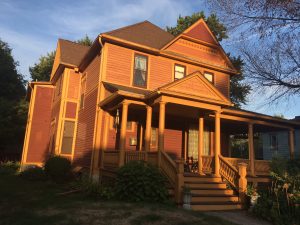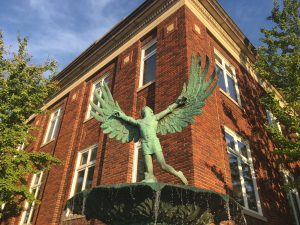
Musings from the Midwest
Things are different here in the Midwest, and those differences are almost all good.
Yes, I’m back once again in the heart of the great American heartland — Ames, Iowa. I’m spending a few weeks hanging out with old friends, eating a ton of that great Midwestern beef at the best barbecue spot anywhere (Hickory Park), and walking and walking and walking some more through Ames’ historic downtown and residential areas.
I come back to Ames every year because, frankly, I’m trying to turn back the clock to about 1981. That was when — after teaching journalism for a couple of delightful years at Iowa State University — we got a bit chilly during one of Iowa’s legendary winters and decided to head for the heat.
That meant quitting the great ISU job and going back into TV news — in this case, in Phoenix. Don’t get me wrong — KPNX was a fine station, and I enjoyed working there. And going back into TV news there meant I eventually would work in television in Detroit, Buffalo, Atlanta, San Francisco and Los Angeles. In those days, not moving from station to station meant you likely “couldn’t” move — in other words, couldn’t get hired in a bigger city — and no one wanted that reputation.
So we moved and moved — and along the way, established what a few might consider an impressive resume. Indeed, I was fortunate to work at several great stations in some very big cities. But all along that hectic way, I knew I had given up something I likely could never get back — namely, a wonderful life in a small, smart, safe Midwestern university town.
So a number of years ago, I began coming back to Ames on extended weekends. Then, when I retired a few years ago, I started spending weeks at a time here — thanks in large part to a former ISU colleague and his wife, who kindly made their home available while they kept trekking to a flat they had in London. In exchange for paying no rent, I took care of their house. It was a great trade.
And finally — after too many “I hate to leave Ames” scenarios that occurred at the end of each of my visits, the wife and I decided to buy a place of our own here — yes, in the historic old-town district — fix it up — and live here half the year (the warm half) once she pulls the plug on her Fresno job.
So here I am — sitting in, yes, our own home in this wonderful town of Ames on a cool summer night. I arrived only a couple of weeks ago and will depart when it turns chilly in October. Next year, we hope to get here in June and stay through Halloween.
And even five or six months a year here won’t be enough. The truth is, Ames is the finest place we’ve ever lived, and as I said before, we’ve resided in lots of places. It is, indeed, the quintessential small university town you’ve seen in those idyllic TV shows or movies.
It is a town that has a great history, starting with railroad barons who picked this spot between the Skunk River and Squaw Creek to plant a depot. That was in 1864. That depot was a couple of miles east of one of the first land-grant colleges in the United States, and for years, there was little or no contact between Ames and what became Iowa State.
But little by little, roads were cut (and later paved and re-paved after floods), a small railroad was established between the campus and the two-block “downtown” on Onondaga Street, and the town-and-gown relationship grew stronger.
Meanwhile, that downtown area burned down once or twice — wooden buildings with wooden sidewalks often do that — before town fathers decided that brick was the way to go.

This was in the 1880’s and ’90s, and to this moment, downtown Ames looks pretty much the way it did then. Oh, yes, the businesses have changed mightily — long gone are the livery stables and Montgomery Wards, Penney’s, the Carr Hardware store and that legendary Ames department store run by the amazing Tilden family.
But unlike a certain Central California city I’m intimately familiar with, downtown Ames never died. It re-invented itself as a cultural destination and kept going — with its buildings remaining lovely and inviting, with new businesses coming in and with a ton of activities taking place.
And as importantly, Ames recognized the need to keep intact its historic residential district just north of town. That required getting it listed on the National Register of Historic Places, and doing so meant that those incredible Queen Anne and American Foursquare and Italianate and Colonial Revival homes that early residents had built in the 1870’s onward would remain in pristine condition and look largely the way they looked way back then.

I walk through that historic district every day. In fact, I walk several miles every day, and every neighborhood — historic or not — is lovely with overgrown trees that canopy streets and with lawns watered only by thunderstorms that occasionally rumble through.
I’ve already spent several hours at the Historical Society office — which is in a grand brick building that replaced one of Ames’ first residential hotels. Across the street is an historic brick building put up by one of the town’s true giants — Capt. Wallace Greeley — who, after serving in the Civil War, arrived in Ames and proceeded, among other things, to construct the Ames Masonic Building (the one across from the Historical Society), the First National Bank Building, a personal home that was the envy of its time and, oh yes, the city’s hospital. And I must not forget that he donated the land for the city’s Carnegie-funded library.
Yes, the Greeleys were giants in the early days of Ames. And so were the Tildens and the Munns and Parley Sheldon and the Bauges — and none of them could have been such major players without Cynthia Duff, who bought some land and then sold it to John Blair the railroad man, who then named “his” town Ames in honor of his friend, Cong. Oakes Ames.
So Ames has history that it’s wisely kept on the front burner and historic buildings that it’s wisely not torn down. (Among those old structures are churches built near downtown more than 100 years ago. They are impressive sights.)
Ames also has culture (with many big-name performers showing up at Stephens Auditorium at the Iowa State Center) and big-time college athletics (Iowa State is in the Big 12 conference, meaning we get to play Texas and Oklahoma and Oklahoma State and Baylor, among others, each football and basketball season).
And perhaps most importantly, Ames is a “smart” town. A large portion of its population has bachelors and masters degrees, and a significant number of people have PhD’s. That means a generally high level of discussion on issues that come before the City Council and school board. It also means Ames High students have high college test scores, and that a whole lot of them do, indeed, move on to college.

And there’s another thing about Ames. (Well, there are many things about Ames, but I’ll just mention one.) It’s safe. For years since I’ve started coming back, I’ve taken extensive walks around town. No matter when I walk — day or night — or where — I feel safe. This is not to say there is no crime here, but what crime there is tends to involve petty thefts or auto thefts in the Campustown area west of downtown.
Ames residents tend to be “progressive” — after all, it is a town dominated by a big-time university. But “progressive” does not mean “extreme.” Indeed, it’s a delight to tune into local radio — yes, Ames has a news-talk station — and not hear crazy right-wing or left-wing rants. The local talk-show hosts are moderate — they actually can see both sides of an issue — and they are, in a word, “nice.” And even after listening to Ames radio for years, it’s still somewhat amazing to me that during the 7 a.m. local morning news on KASI, newscaster Trent Rice reads funeral notices.
You may have heard of this thing called “Iowa nice.” It really exists. Residents here are, simply, much friendlier than those in California. They seem more relaxed, as well. Many go walking with their wives and husbands and children in the evenings, and all will greet you — if you want to be greeted.
One of the better things about living in the Midwest is that prime-time network TV — if you still watch such a thing — airs from 7 to 10 p.m. — not 8 to 11, like we endure on the West Coast. That means every network affiliate’s news comes on at 10, and that Fallon and Colbert begin at 10:35. That’s nice, especially for old guys like me who need our beauty sleep (or who just get tired earlier than we used to).
However, all is not a bed of roses when it comes to TV. Out this way, I can only watch the Cardinals or Royals or Twins on my cable sports channels. No Dodgers. But I’ll attempt to survive until I return to the Valley.
And, yes, I will return — at least for awhile, until the wife retires right after the New Year and we move on to the “rest” of our lives. That means spending winter and spring on the Central Coast of California, and summer and autumn here in Ames.
It also means leaving Fresno after living most of my life there. But that story is for another day, a few months down the line. Between now and then, I’ll be walking and eating too much barbecue here in Ames and, later this year, walking again around Fresno and seeing what happens when Fulton is re-opened. Yes, I’ve been following the Bee and its stories about how everyone’s so excited about that mall being ripped out.
So when I return, I expect to see hordes of people enjoying the re-opened Fulton Street. Until then, I’ll make do with walking down Main Street (that’s what Onondaga became when it was first paved in 1910) here in Ames, looking at all the lovely historic buildings and thinking about how nice it is to spend quality time in this Midwestern hamlet.
Is this heaven? Sure. It’s Iowa.
